Guitar tablature, commonly known as “guitar tabs,” is a revolutionary system of music notation that empowers aspiring guitarists to learn songs swiftly and effortlessly. Guitar tabs share common ground with traditional music notation by indicating the notes, durations, and techniques required to play music. However, guitar tabs offer a significant advantage over standard notation, especially for beginners: they visually represent where to play the notes directly on the guitar.
This visual approach is particularly beneficial because the guitar fretboard allows for playing the same note in multiple locations. Therefore, grasping guitar tablature and learning how to decipher guitar tabs is exceptionally valuable for beginners. It provides a gateway to playing guitar and learning your favorite songs without the initial hurdle of mastering conventional musical notation.
At guitarplayers.net, we understand the power of guitar tablature. We champion teaching How To Read Guitar tabs because they effectively illustrate both chords and single notes. This makes tabs the quickest route to learning songs you love. The beauty of guitar tabs lies in their simplicity. No prior musical knowledge is needed beyond understanding the layout of your guitar strings and frets.
If you’re eager to discover the world of guitar tabs and unlock their potential, you’ve arrived at the perfect starting point. Let’s dive in and begin your journey.
What is Guitar Tablature?
Guitar tablature is essentially a visual map of music for guitarists. It translates the notes of a song into a format that’s directly applicable to the guitar fretboard. A standard guitar tab is composed of six horizontal lines, each representing one of the six guitar strings. When learning how to read guitar tabs, it’s crucial to understand that the lines are read from top to bottom, corresponding to the guitar strings from the high E string (the thinnest string) at the top, down to the B, G, D, A, and low E strings (the thickest string) at the bottom.
This arrangement mirrors how you see the strings when you look down at your guitar in playing position. Think of guitar tablature as your personal roadmap to musical fluency on the guitar. It provides the most direct path to learning songs and musical pieces.
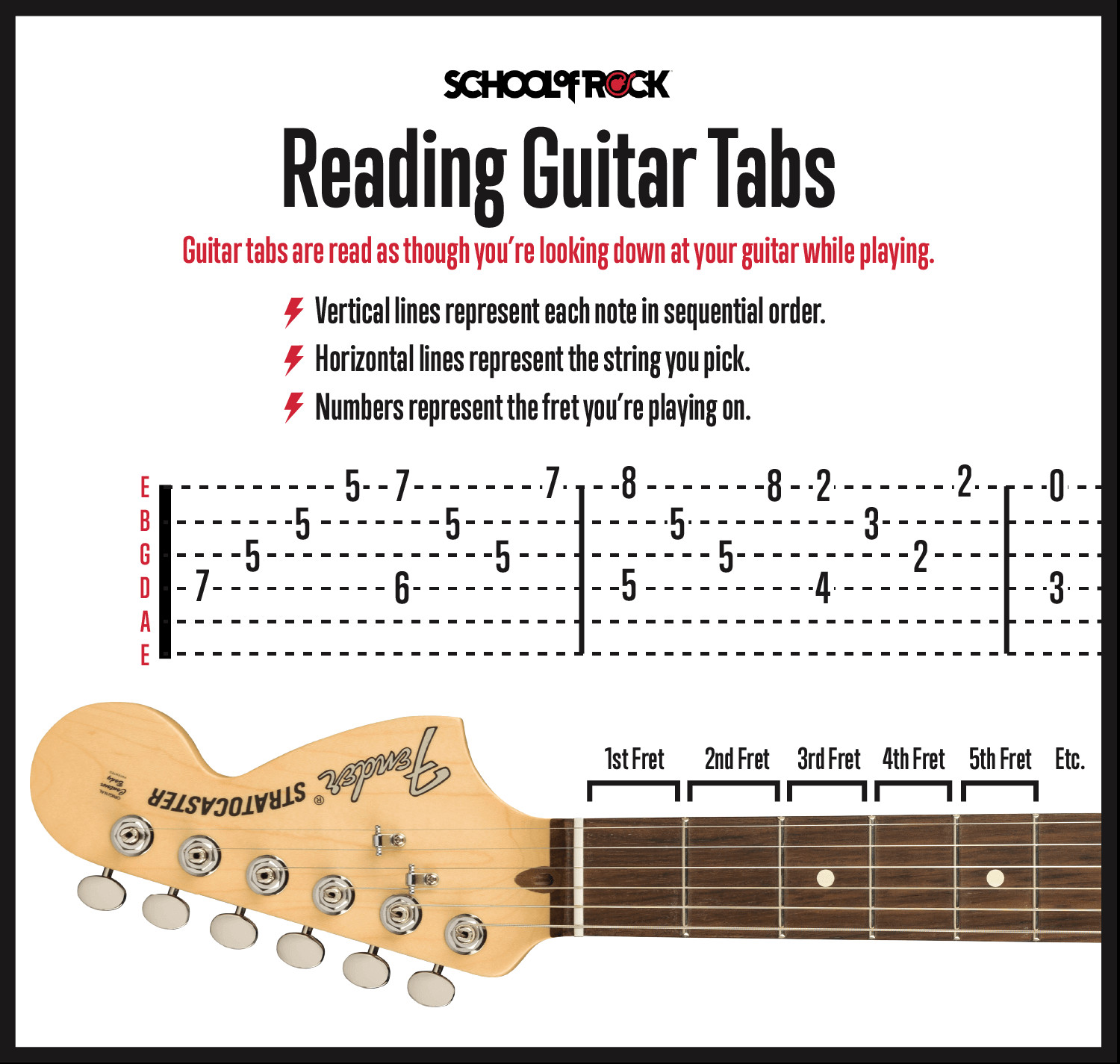 Reading guitar tabs
Reading guitar tabs
Within guitar tablature, you’ll notice numbers placed on these lines. These numbers represent the frets on your guitar. Frets are the metal strips that run perpendicular to the strings along the fretboard. They are numbered from 0 to 24 (or sometimes more, depending on the guitar), starting from the nut (the piece closest to the headstock) and extending down the guitar neck.
A “0” on a string in a tab indicates that you should play that string “open,” meaning you pluck or pick the string without pressing down on any fret with your fretting hand. If you see a “1” on a string, it means you should play the note at the first fret on that string. As you continue learning how to read guitar tabs, remember that ‘1’ always corresponds to the first fret, ‘2’ to the second fret, ‘3’ to the third fret, and so on.
Decoding Guitar Tab Notation: A Step-by-Step Guide
Reading guitar tablature is a straightforward process. You read tabs from left to right, just like standard text. The notes in a tab are presented in the order they occur in the music, chronologically. When you encounter numbers stacked vertically on the tab staff, they represent a chord. A chord is played by strumming all the indicated strings simultaneously. Guitar tab notation holds a significant advantage for beginners over standard notation because it not only tells you which notes to play to form a chord, but also precisely where to play them on your guitar.
Essential Elements of Guitar Tabs
To successfully learn how to read guitar tabs, beginners need to familiarize themselves with the fundamental components of guitar tablature and the guitar itself: the six strings and the fret positions. This foundational knowledge will enable you to accurately locate the notes indicated in the tab and translate them into music on your instrument.
The 6 Strings of the Guitar
The guitar tab staff, while visually similar to the staff in standard notation, has a key difference. The lines in guitar tab don’t represent musical pitches directly, but instead, they symbolize the 6 strings of the guitar.
The topmost line of the tab staff corresponds to the high E string, which is the thinnest string and produces the highest pitch. Descending downwards, the lines represent the B, G, D, A, and finally, the bottom line represents the low E string, the thickest string producing the lowest pitch. This direct string representation makes learning and how to read guitar tabs inherently intuitive for beginners. To avoid confusion with standard notation, guitar tabs are typically labeled “TAB”.
Understanding Guitar Frets
Guitar frets are the metal strips embedded in the fretboard that run perpendicular to the strings. They are essential for changing the pitch of a string.
Most guitars feature anywhere from 19 to 24 frets. The distance between each fret represents one semitone or half step in musical pitch. Within each octave, there are 12 semitones (or frets). To aid in navigation, most guitars have fret markers – often dots or inlays – positioned at specific frets, typically the 3rd, 5th, 7th, 9th, and 12th frets. These markers offer visual cues to help you quickly identify fret positions while playing.
When interpreting numbers on the guitar tab staff, remember that these numbers indicate the fret to be played. A “0” signifies an open string, played without fretting. Numbers 1 and above indicate the fret number to be pressed down while picking or plucking the string.
Reading Guitar Tab Chords
Guitar chords in tablature are easily identifiable by their vertical arrangement. When multiple numbers are stacked directly above each other on the tab staff, it signifies that these notes should be played together as a chord. You play a chord by strumming across all the strings indicated in the vertical stack. Even if a chord is arpeggiated, meaning the notes of the chord are played individually rather than simultaneously, it will still often be represented in tab as single notes played in sequence, even though the underlying harmonic structure is a chord.
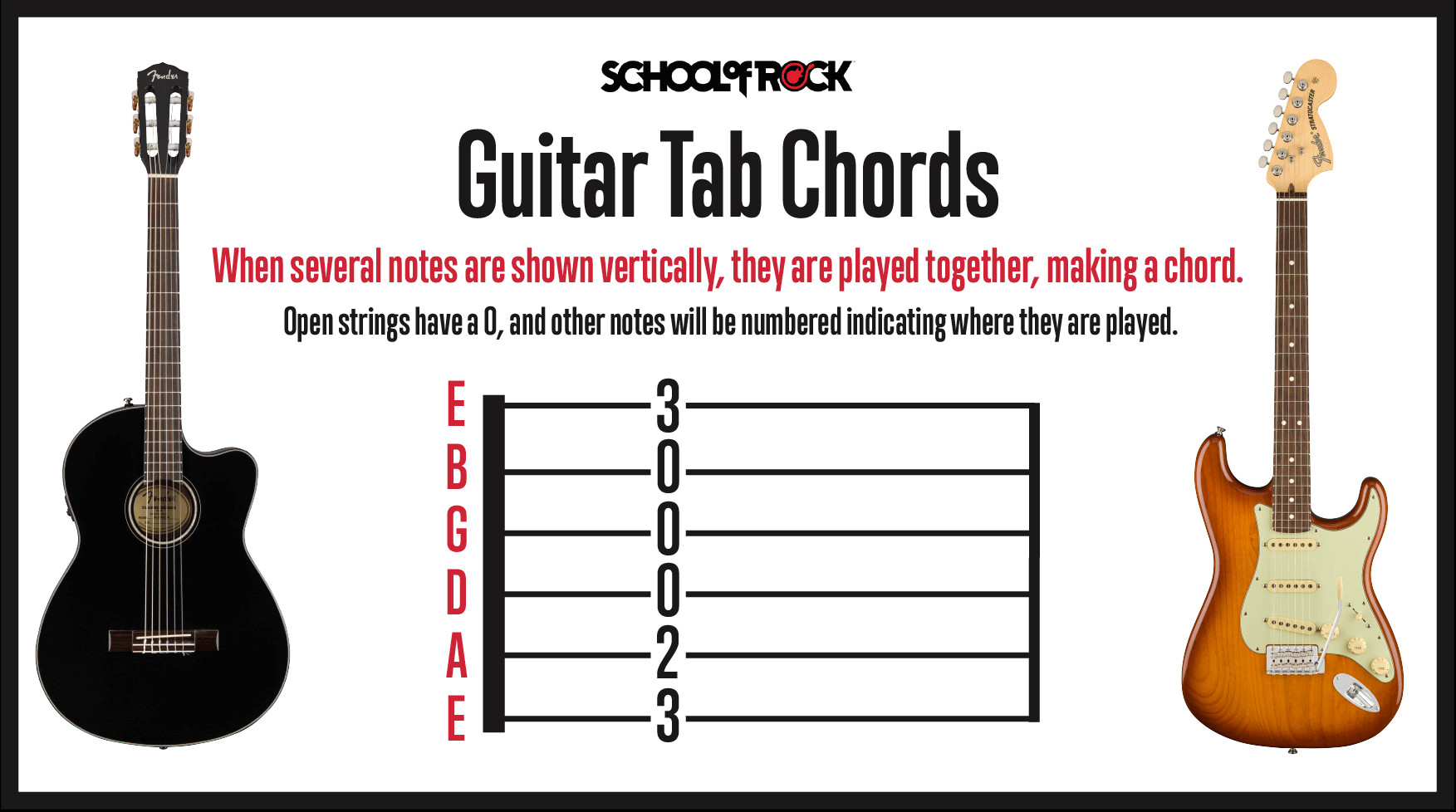 How to read guitar tab chords
How to read guitar tab chords
Interpreting Guitar Riffs
Many popular guitar-based music genres, especially Rock, heavily feature riffs. Riffs are short, repeated musical phrases, often forming the backbone of a song. They typically consist of a combination of single notes and partial chords, such as power chords. When reading guitar tabs for riffs, the same principles apply: vertically aligned notes are played together. This consistency makes learning how to read guitar tablature efficient and user-friendly, even for complex-sounding riffs.
Guitar Tabs vs. Chord Charts
While guitar tabs provide a linear, detailed representation of music, chord charts offer a different, more diagrammatic approach. A chord chart is a visual representation of the guitar fretboard, displaying where to place your fingers on specific frets to form a particular chord. Chord charts often include finger numbers to guide finger placement. They are frequently used to quickly indicate chord changes in song lyrics.
Chord charts typically show only the essential 3 or 4 notes that constitute a basic chord. However, a full and nuanced guitar part often incorporates single notes, passing notes outside the basic chord, or arpeggios – the individual notes of a chord played in a sequence. For this reason, chord charts are often used in conjunction with guitar tabs. Chord charts can provide a quick overview of the harmonic structure, while tabs offer the precise details needed to play a song accurately, including melodies, riffs, and fills.
Fingers and Numbers in Tabs
Guitar tablature is linear, progressing from left to right and representing the musical timeline. In contrast, chord charts are like snapshots of the fretboard, focusing on chord shapes at specific moments. Chord charts often use a numbering system to indicate which fingers of the fretting hand should be used for each note in the chord. The index finger is typically designated as 1, the middle finger as 2, the ring finger as 3, and the pinky finger as 4.
It’s important to note that in guitar tabs, numbers indicate the fret number to be played, not which finger to use. Fingerings are generally left to the player’s discretion in tabs. For beginners, however, some easy guitar tabs may include chord charts with finger numbers to help guide hand positioning during chord changes.
Guitar Tab Symbols and Techniques
Beyond lines and numbers, guitar tabs incorporate a range of symbols to indicate specific guitar techniques. Understanding these symbols is crucial for accurately interpreting tabs and making your playing sound authentic. Mastering how to read guitar tabs and their symbols unlocks a deeper level of musical expression on the guitar.
Before you start playing any tab, it’s always essential to ensure your guitar tuning is correct. Playing with an out-of-tune guitar will not produce the intended sound, regardless of how accurately you read the tab.
Muting Techniques
Muting is a fundamental guitar technique, particularly prominent in genres like Rock, Metal, Punk, and Alternative. Muting techniques are used to control the sustain and character of notes, adding rhythmic and dynamic interest to guitar parts.
How to Mute Guitar Notes
Muting can be achieved with either the picking hand, the fretting hand, or a combination of both. Effective muting is a hallmark of polished guitar playing, preventing unwanted noise and feedback, especially at higher volumes. In many songs, muting is strategically employed to differentiate sections, such as muted verses contrasting with unmuted choruses.
Experienced guitarists often incorporate muting techniques instinctively, even without conscious effort. It becomes an integral part of their playing, ensuring a clean and controlled sound.
Guitar Technique: Palm Muting (P.M.)
Palm muting is one of the most frequently used muting techniques in rock guitar and related genres. It’s achieved by lightly resting the palm of your picking hand on the strings near the bridge while picking. The amount of pressure applied by the palm determines the degree of muting. Heavy palm muting creates a tight, percussive, rhythmic sound, while lighter palm muting allows more of the note’s sustain to ring through. In guitar tabs, palm muting is typically indicated by the abbreviation “P.M.” placed above the section of the tab where palm muting should be applied.
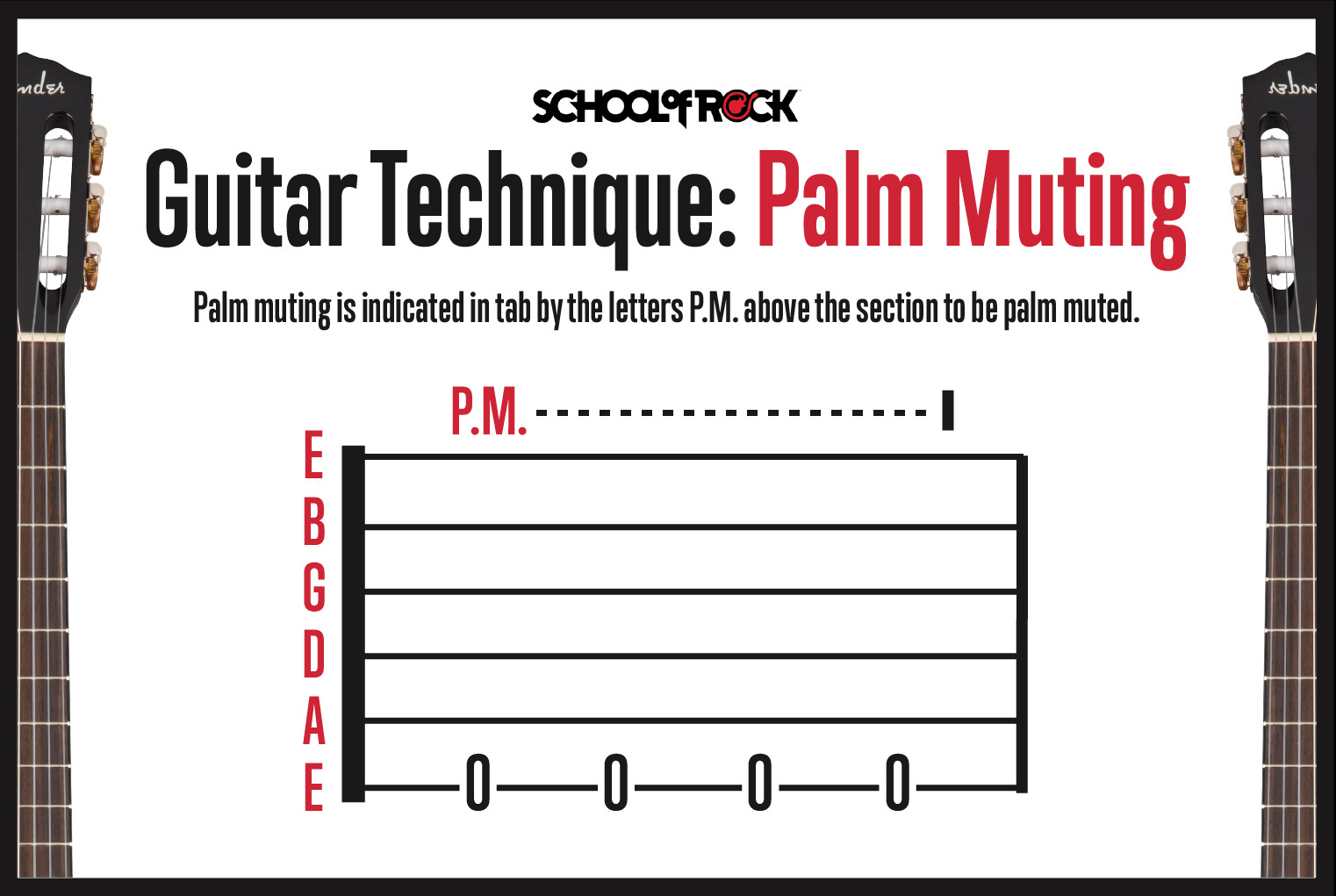 Guitar technique palm muting
Guitar technique palm muting
Guitar Technique: Muted Notes (X)
Muted notes, sometimes called “dead notes,” are another form of muting achieved with the fretting hand. In this technique, the strings are picked, but the fretting hand lightly touches the strings without pressing them down firmly enough to produce a clear pitch. This results in a percussive, muted sound. In guitar tablature, muted notes are represented by an “X” in place of a fret number. The “X” indicates that the string should be played, but muted.
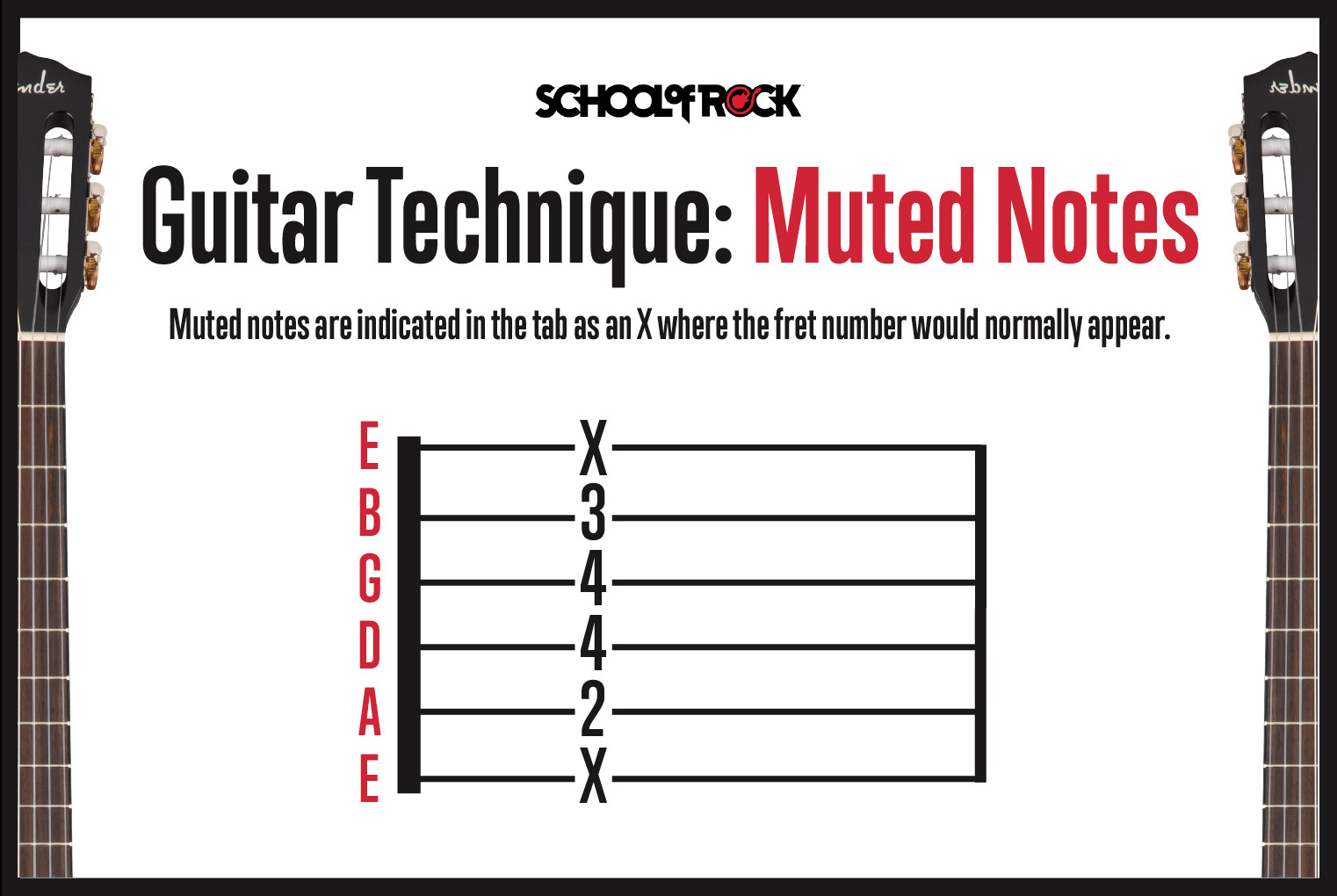 Guitar technique muted notes
Guitar technique muted notes
String Bending
Bending guitar strings is a technique used to add expressive, vocal-like qualities to guitar playing. Bends alter the pitch of a note, creating a smooth transition to a higher note. In guitar tabs, bends are indicated by a curved arrow extending from the note being bent. The arrow may include notations like “½” or “full” step, indicating the desired interval of the bend – a half step (one fret) or a full step (two frets) higher in pitch. The target pitch of the bend is often referred to as the “target note.”
How to Bend Guitar Strings
String bending involves pushing or pulling the string sideways across the fretboard, rather than just pressing down vertically onto the fret. For most strings (except the low E), bending is typically done by pushing the string upwards towards the ceiling. The low E string is usually bent downwards towards the floor. The key to a good bend is applying smooth, consistent pressure to the string throughout the bend.
Guitar Technique: Bending Guitar Strings
Most bends are executed using a combination of fingers for added strength and control. Typically, the “main” fretting finger (often the ring finger) performs the bend, while the middle and index fingers provide support and stability. This multi-finger approach results in smoother, more controlled bends and better pitch accuracy.
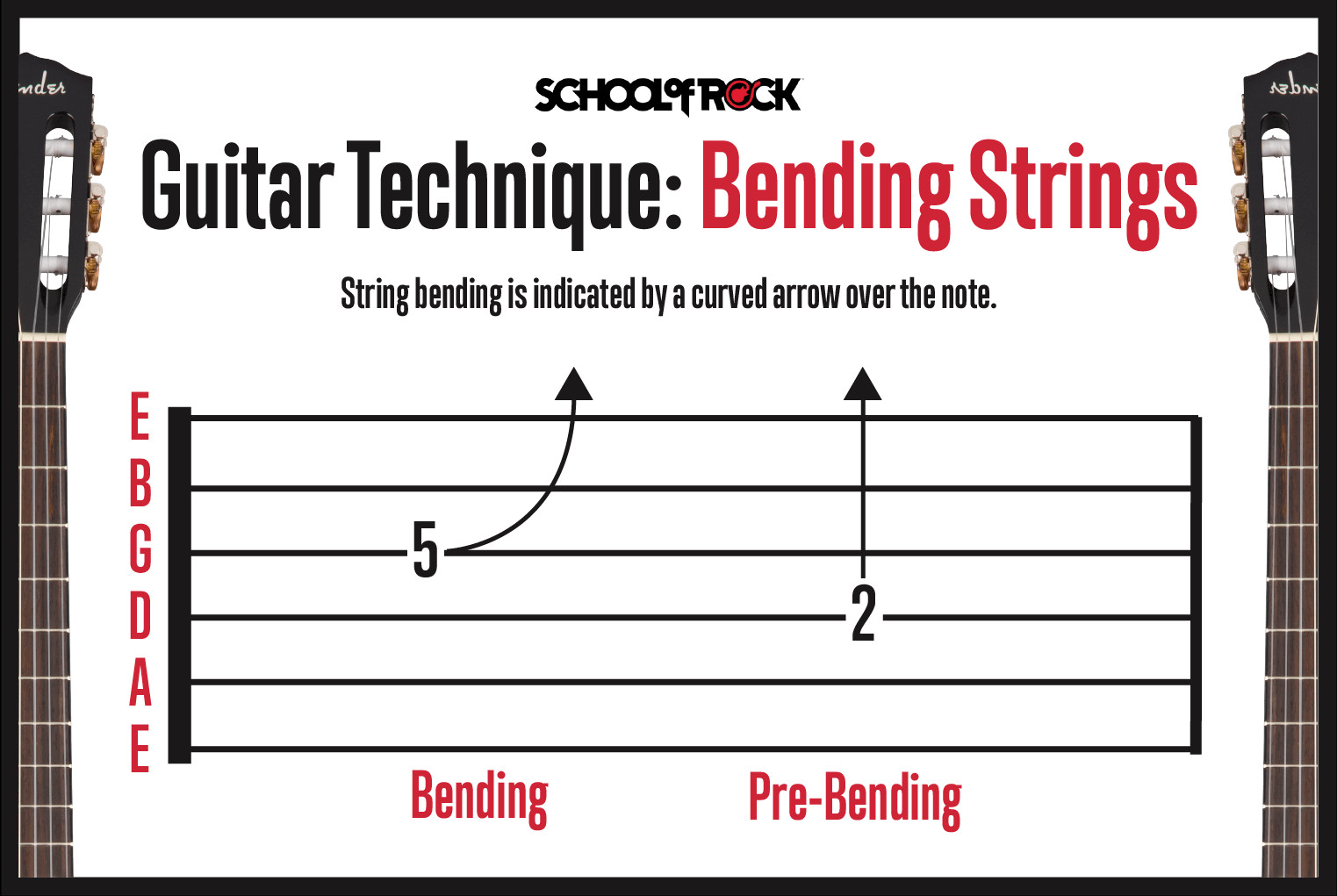 Guitar technique bending strings
Guitar technique bending strings
Guitar Technique: Pre-Bending Guitar Strings
Beginners learning how to read tabs on a guitar might also encounter pre-bends. A pre-bend involves bending a string before picking it. The tab notation for a pre-bend starts with an upward arrow indicating the bend amount (e.g., “full,” “½”), followed by a downward curved arrow after the note, signifying the release of the bend back to the original pitch. Pre-bends can resolve back to the original fretted note or bend further upwards to another target note, adding another layer of expressive possibility.
Sliding Notes
Sliding is another essential guitar technique that creates a smooth transition between notes. You can slide upwards to a higher note or downwards to a lower note. Unlike bending, sliding involves moving the fretting finger along the fretboard while maintaining pressure on the string.
Guitar Technique: Slide Up
In guitar tabs, a slide up is represented by a line connecting the note you are sliding from to the note you are sliding to. If the slide is upwards to a higher-pitched note, the connecting line may angle slightly upwards.
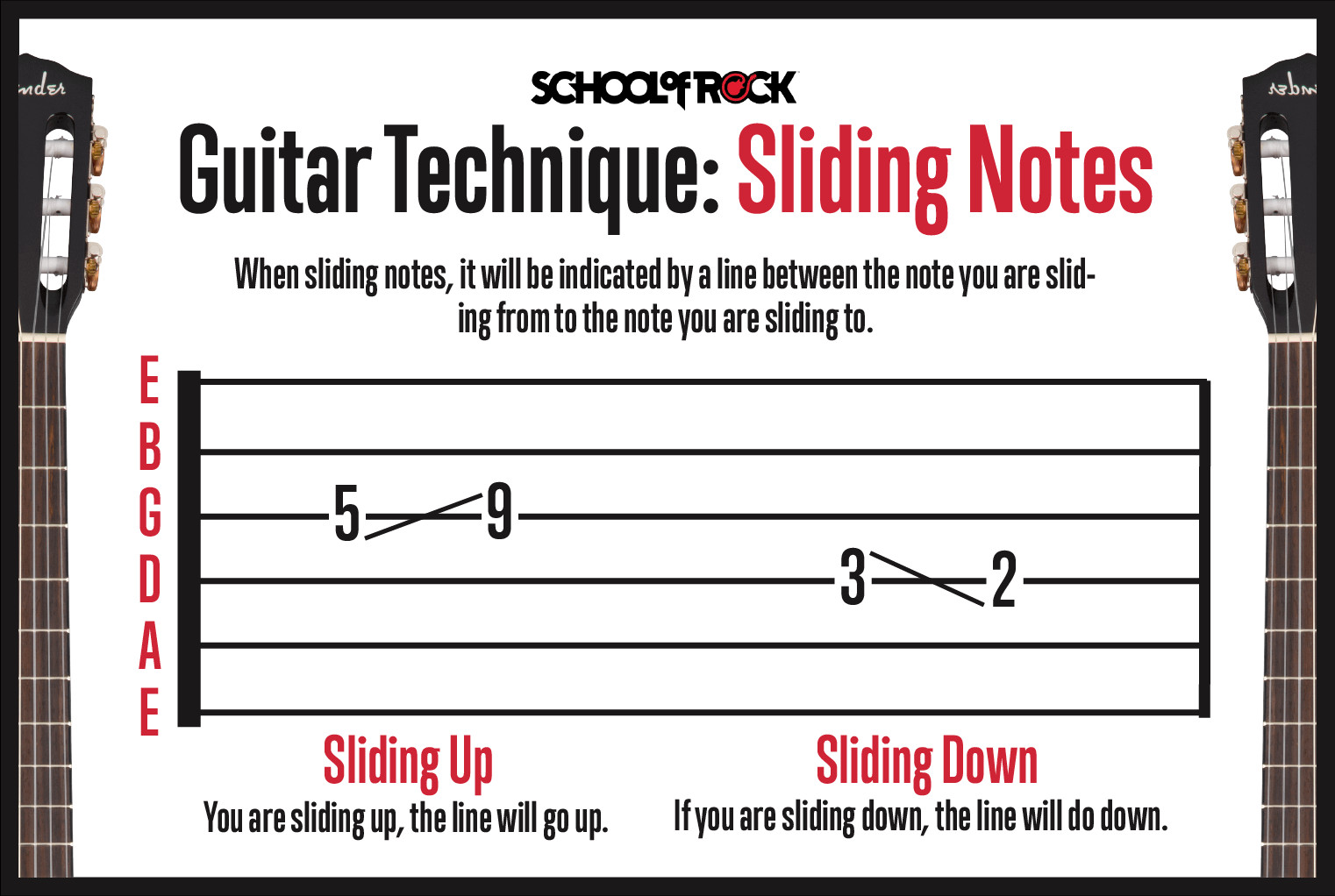 Guitar technique sliding notes
Guitar technique sliding notes
Guitar Technique: Slide Down
Conversely, a slide down is also represented by a line between the starting and ending notes. If the slide is downwards to a lower-pitched note, the line may angle slightly downwards.
Playing Hammer-Ons on the Guitar
The hammer-on is a technique where you produce a note by “hammering” your fretting finger onto the string behind a fret, without picking the string again. You can hammer-on from an open string or from a previously fretted note, and the resulting note will be higher in pitch. In guitar tabs, hammer-ons are indicated by the letter “H” placed between the two notes, often connected by an arc.
How to Play Hammer-Ons on the Guitar
To execute a hammer-on, strike the string with your fretting finger with sufficient force to make the note sound clearly. This requires some practice to develop the necessary finger strength and technique. Hammer-ons are generally easier to execute on electric guitars, especially at higher volumes. A good starting exercise is to play an open low E string and then hammer-on to the third fret with your index finger, letting the note ring. Repeat this exercise on different strings and frets to build proficiency.
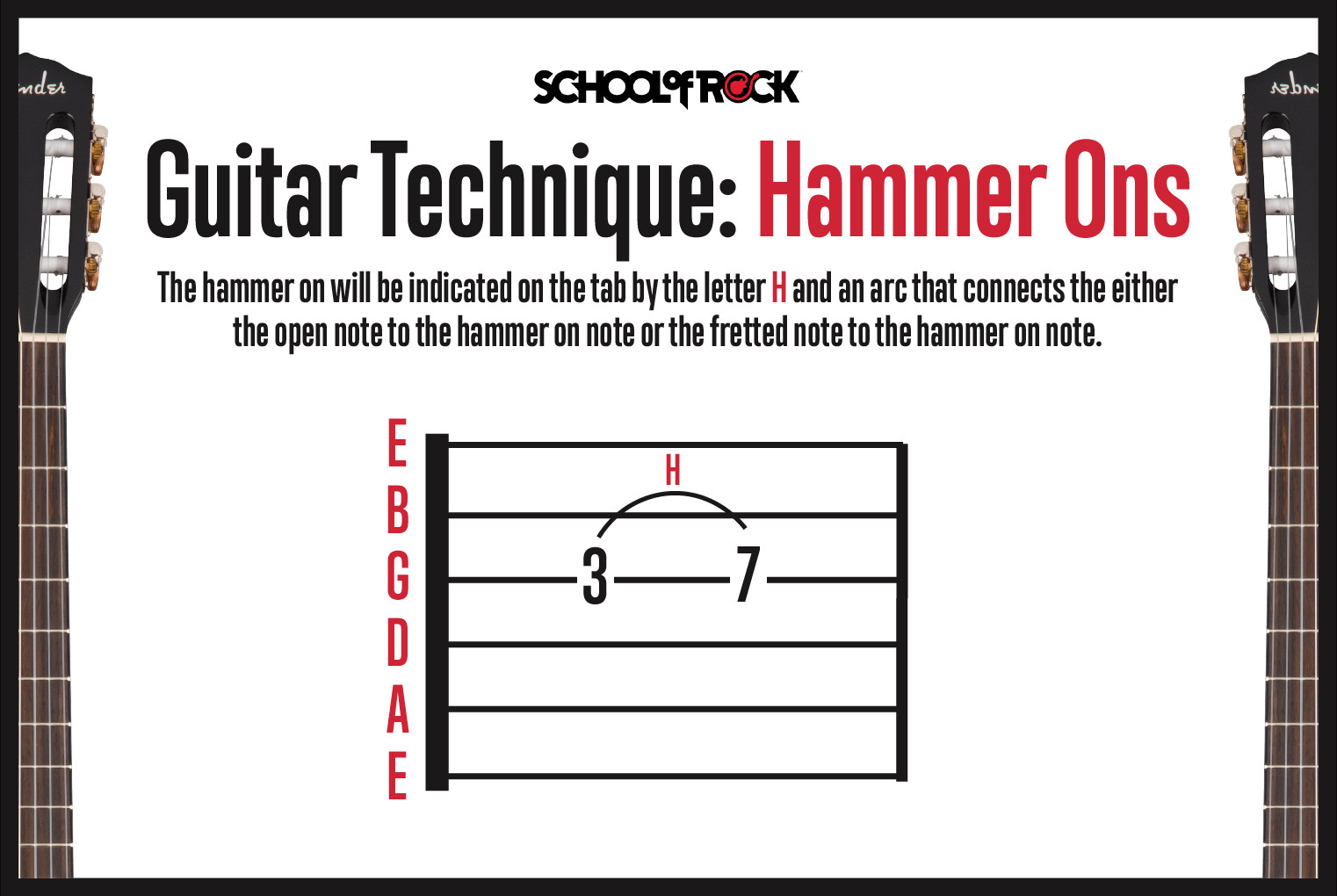 Guitar technique hammer ons
Guitar technique hammer ons
Playing Pull-Offs on the Guitar
Pull-offs are the opposite of hammer-ons. Instead of hammering onto a string, you “pull off” a fretted note to sound either an open string or a lower fretted note (already being fretted by another finger). Pull-offs also eliminate the need for picking the string again. In guitar tabs, pull-offs are indicated by the letter “P” between the two notes, often connected by an arc. The resulting note after a pull-off will always be lower in pitch.
How to Play Pull-Offs on the Guitar
To perform a pull-off, fret a note and then pull your fretting finger sideways and slightly downwards, “pulling off” the string in a way that causes it to vibrate and sound the next desired note (either an open string or a lower fretted note). When playing pull-offs, you need to “grab” enough of the string with your fingertip to initiate vibration.
Hammer-ons and pull-offs can be combined in alternating sequences to create rapid, fluid passages. This combination of techniques, rapidly alternating between hammer-ons and pull-offs, is sometimes referred to as a “trill.”
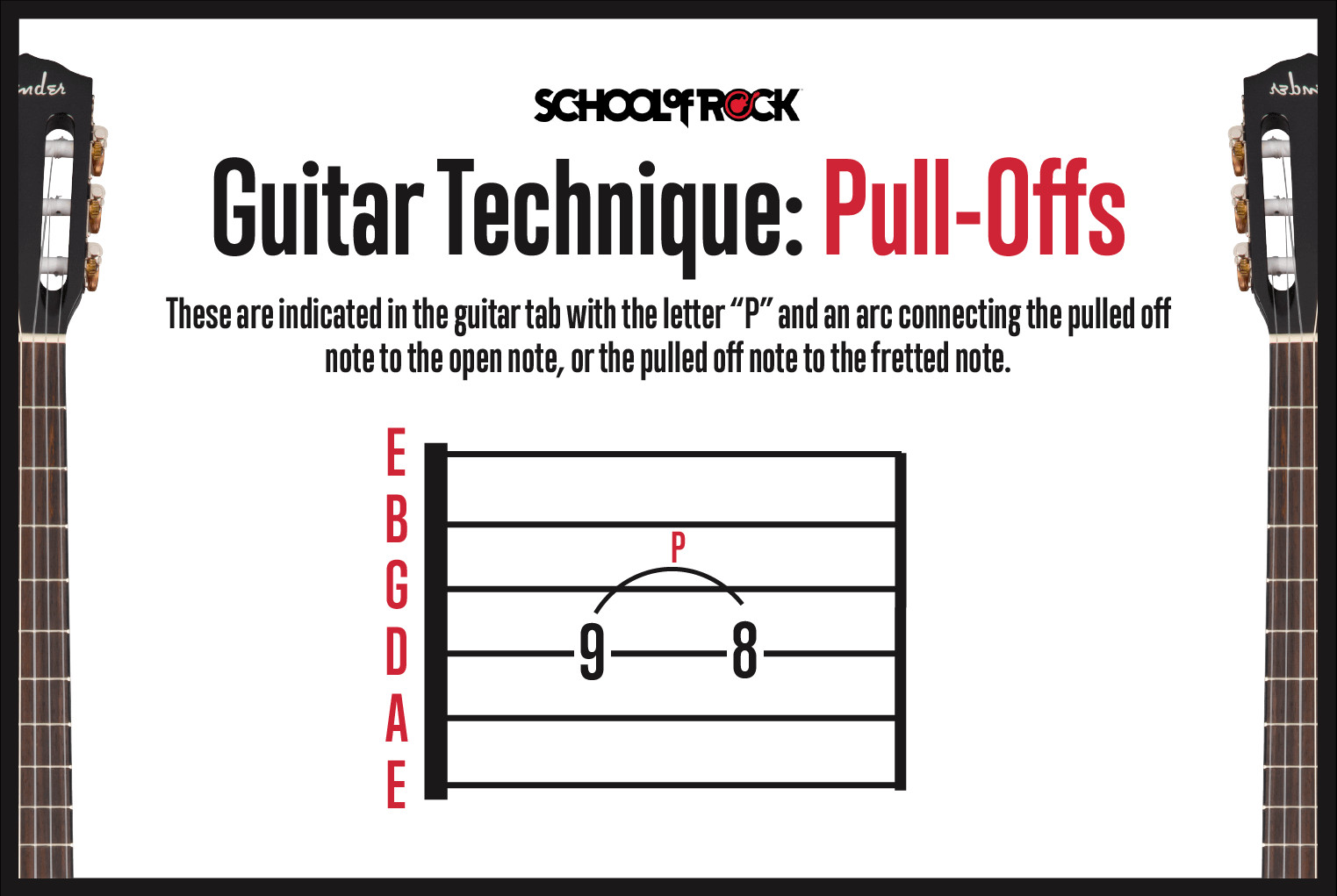 Guitar technique pull offs
Guitar technique pull offs
Playing Vibrato on the Guitar
Vibrato is a technique that adds warmth and expressiveness to sustained notes. It involves subtly and rapidly varying the pitch of a note up and down, creating a pulsating or shimmering effect. In guitar tabs, vibrato is typically represented by a zig-zag line placed above the note. When learning how to read guitar tablature, pay attention to the length of the zig-zag line. Generally, a longer line indicates that vibrato should be applied for a longer duration.
How to Play Vibrato on the Guitar
Vibrato is similar to bending, but with a much smaller pitch variation and a repeated, rhythmic motion. Vibrato can be achieved using a single finger or by using a main finger with supporting fingers for added control. Start by practicing slow, smooth vibrato and gradually experiment with different speeds and widths of pitch variation to achieve different expressive effects. Like bending, vibrato is a highly personal technique, and each guitarist develops a unique vibrato style.
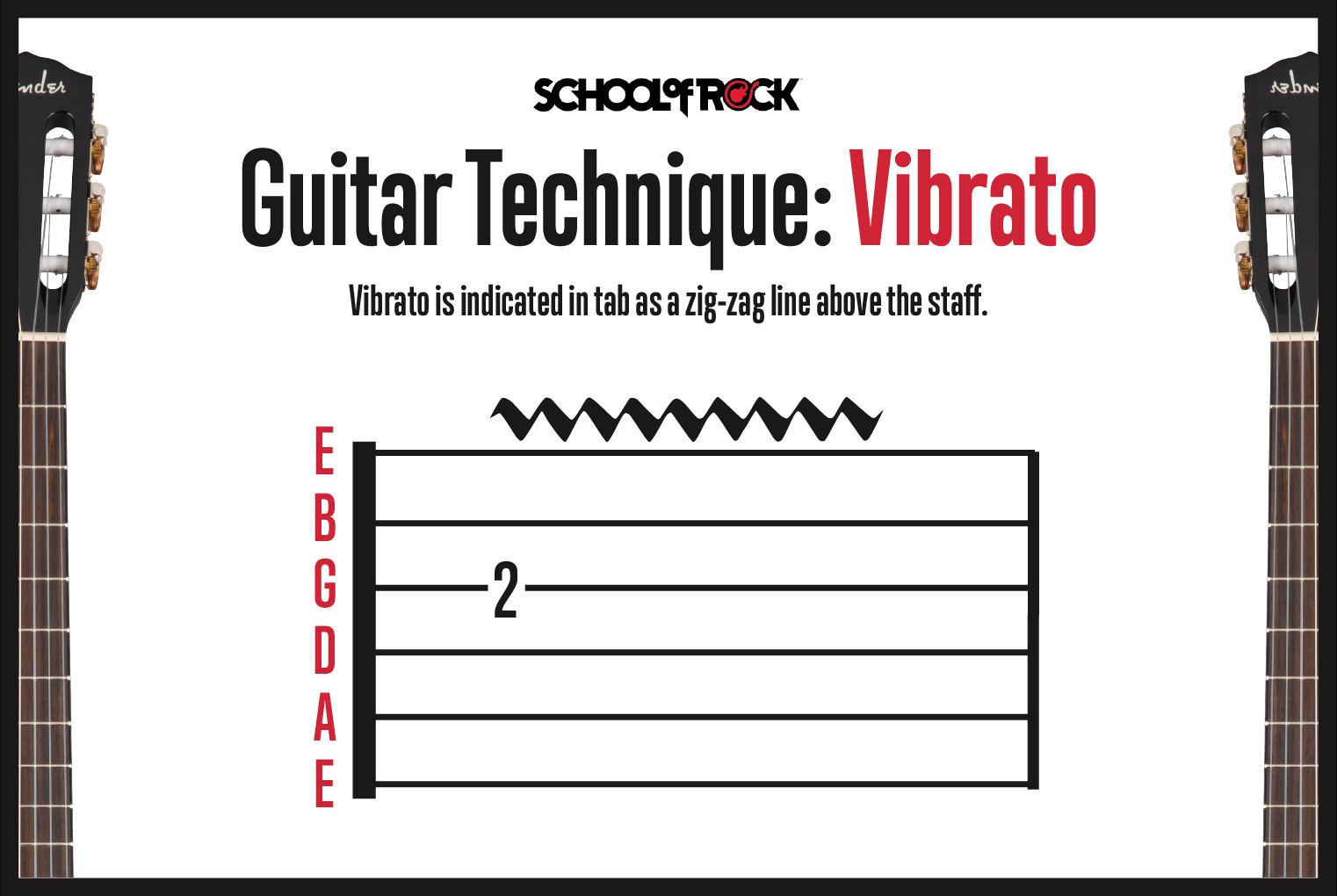 Guitar technique vibrato
Guitar technique vibrato
Tapping Guitar
Tapping is an advanced guitar technique that involves using the fingers of your picking hand to fret notes on the fretboard, in addition to your regular fretting hand. It’s a percussive and efficient way to play fast passages and wide intervals. Tapping is notated in guitar tabs with the letter “T” placed above the tapped note. In essence, tapping with the picking hand is a variation of a hammer-on.
How to Finger Tap Guitar
Tapping was popularized by guitar virtuoso Eddie Van Halen, though the technique has roots in classical guitar. To finger tap, fret a note with your fretting hand as usual, and then “tap” a higher note on the same string by sharply striking the fretboard behind a higher fret with your picking hand’s index finger.
Finger tapping effectively extends the reach of your fretting capabilities. It allows you to play notes at intervals that would be impossible to reach with just your fretting hand alone. Playing with overdrive or distortion and at a decent volume enhances the clarity and sustain of tapped notes. Tapping also enables rapid playing because both hands are actively fretting notes.
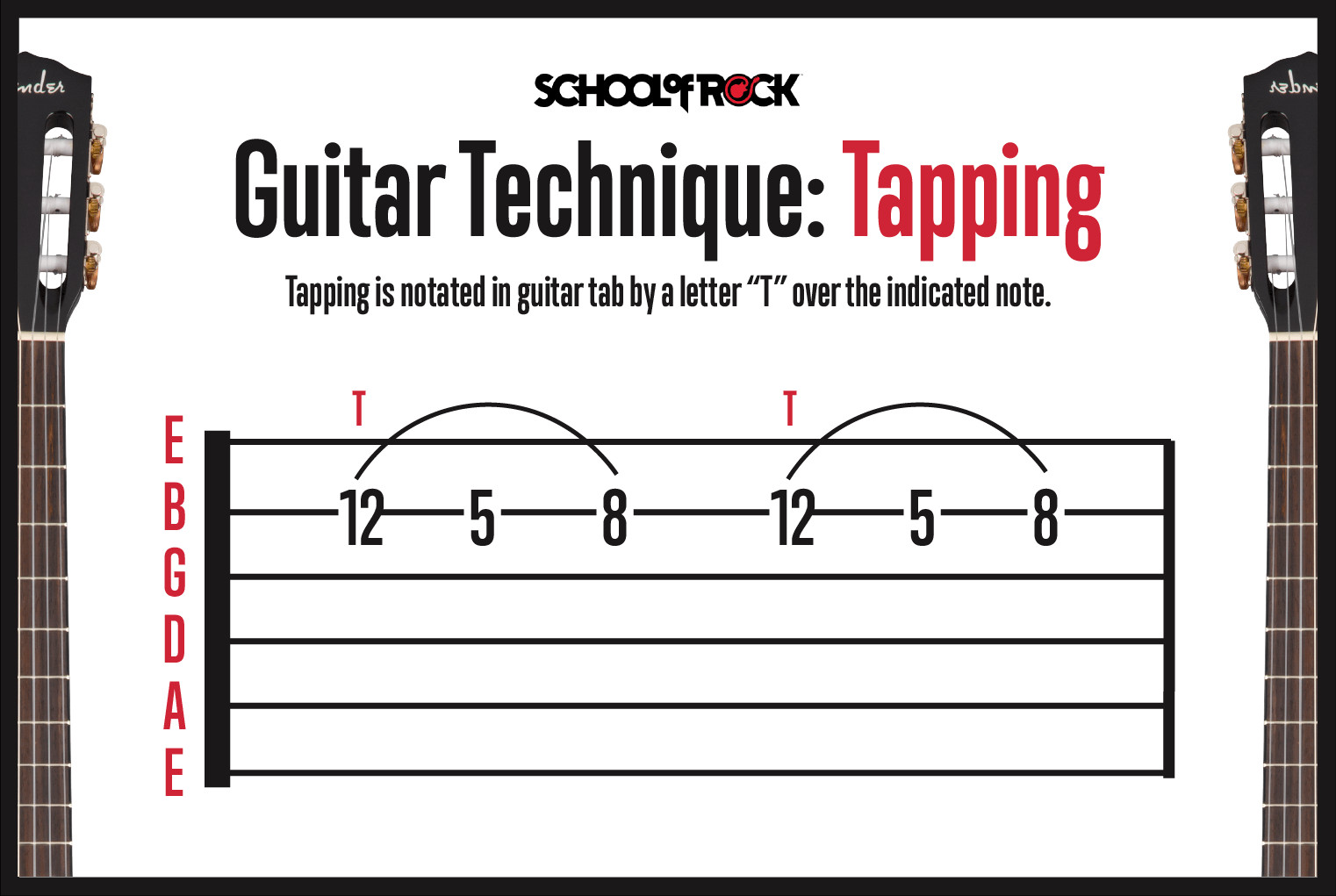 Guitar technique tapping notes
Guitar technique tapping notes
Guitar Technique: Two-Handed Tapping
Two-handed tapping takes the tapping concept further. It involves both the fretting hand and the picking hand independently tapping notes on the fretboard, without traditional picking. This allows for incredibly complex and polyphonic textures. Two-handed tapping is sometimes used to create arrangements where the fretting hand taps bass lines while the picking hand taps melody or solo lines.
Strumming Guitar Notes
When playing chords on the guitar, strumming is the technique used to play all the chord notes in rhythm. Strumming involves two basic stroke directions: downstrokes and upstrokes.
Downstrokes are performed by moving the pick or strumming hand downwards across the strings, typically starting from the lower-pitched strings towards the higher-pitched strings. In guitar tabs, downstrokes are represented by a symbol resembling a thick horizontal line with two short “legs” pointing downwards on either side.
Upstrokes are the opposite, performed by moving the pick or strumming hand upwards across the strings, starting from the higher-pitched strings towards the lower-pitched strings. In guitar tablature, upstrokes are notated by a “V” shaped symbol placed above the strummed chord or note.
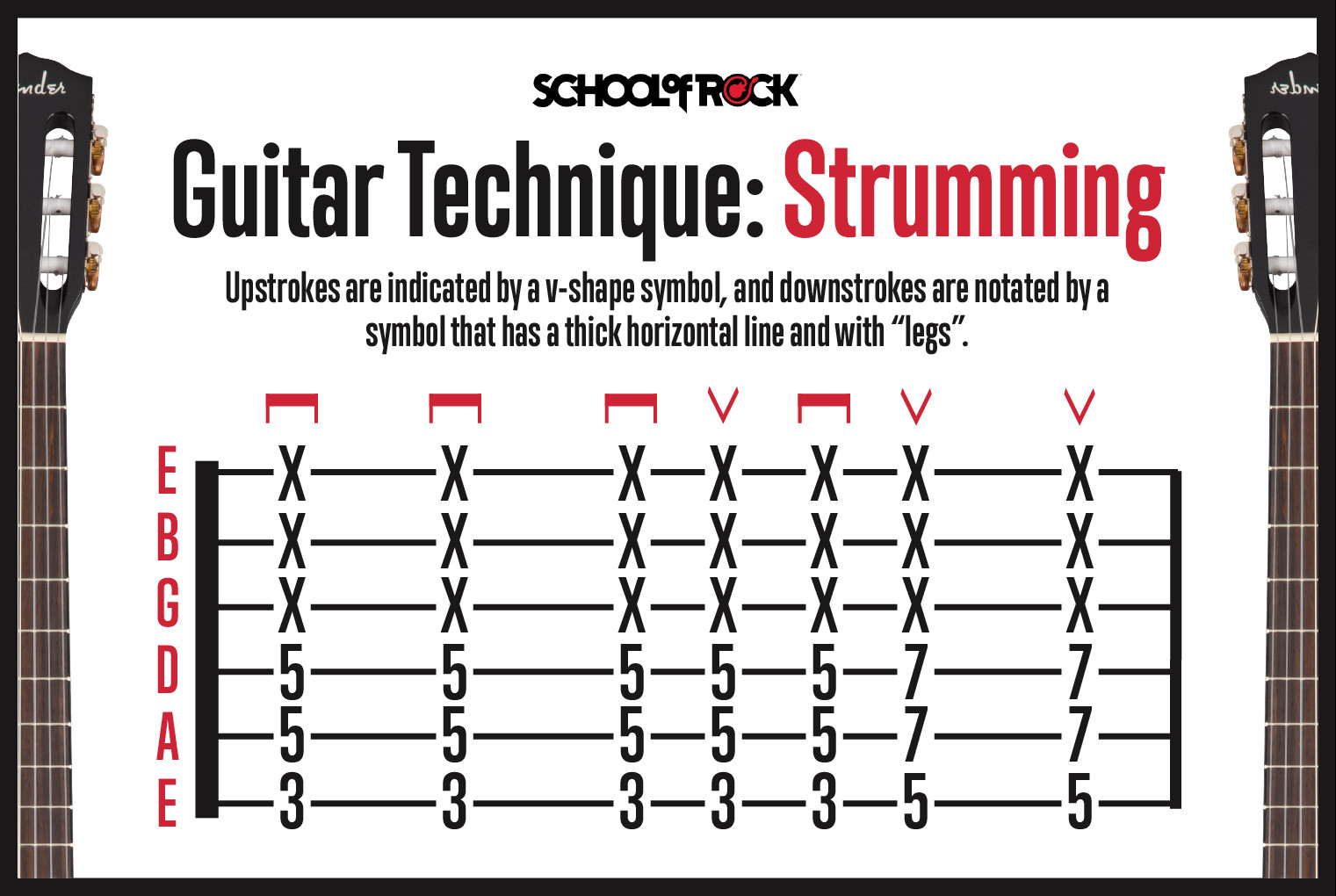 Guitar technique strumming
Guitar technique strumming
How to Strum Guitar Notes
Strumming patterns are rhythmic sequences of downstrokes and upstrokes used to play chords in time with the music’s rhythm. A common strumming pattern involves alternating downstrokes and upstrokes in an eighth-note rhythm. In 4/4 time, this rhythm is often counted as “1 and 2 and 3 and 4 and.” Many songs utilize this alternating pattern, with downstrokes typically falling on the numbered beats (1, 2, 3, 4) and upstrokes on the “ands.”
Guitar Technique: Playing Downstrokes and Upstrokes
The downstroke and upstroke symbols are not only used for strumming chords but also for indicating picking direction when playing single notes in guitar tabs. A downstroke symbol above a single note indicates that the note should be picked with a downward motion of the pick. Conversely, an upstroke symbol above a single note indicates an upward picking motion.
Ready to Learn Other Guitar Techniques?
Now that you’ve learned how to read tabs for guitar and understand a range of guitar techniques, you’re well-equipped to start playing! Whether you’re a complete beginner or aiming for advanced skills, guitarplayers.net is here to support your musical journey. From basic strumming to complex tapping techniques, our resources and expert guidance can help you unlock your full potential as a guitarist.
Ready to find guitar tabs and start playing your favorite songs? From beginner-friendly tunes to challenging pieces for experienced players, we’ve got you covered. Explore our extensive collection of high-quality guitar tabs and sheet music to find the perfect songs to learn and play.
Thinking about getting a new guitar? Check out our comprehensive Guitar Buying Guide!
